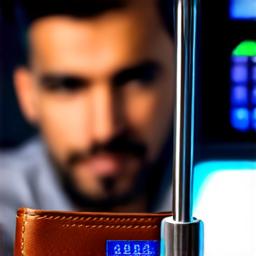Are you a blockchain developer interested in participating in trading activities on a blockchain network? If so, then you’ll need to set up a trading wallet to store and manage your funds. But with so many options available, it can be challenging to choose the right one for your needs. In this comprehensive guide, we’ll explore the different types of blockchain trading wallets, their features, and how to unlock them for maximum efficiency.
Understanding Blockchain Trading Wallets
A blockchain trading wallet is a digital tool that allows users to store and manage cryptocurrencies used for trading activities on a blockchain network. These wallets come in various forms, including hot wallets, cold wallets, and paper wallets. Each has its advantages and disadvantages, which we’ll discuss in detail below.
Hot Wallets
Hot wallets are digital wallets that allow users to access their funds from anywhere with an internet connection. They are ideal for traders who need to conduct frequent transactions or have a high level of activity on the network. Hot wallets can be accessed via a web browser, mobile app, or desktop application, making them highly convenient and user-friendly.
However, hot wallets are not as secure as cold wallets because they are connected to the internet, which increases the risk of hacking and theft. Therefore, it’s crucial to choose a reliable hot wallet provider that uses strong security measures to protect your funds.
Some popular hot wallet providers include MetaMask, MyEtherWallet, and Coinbase Wallet.
Cold Wallets
Cold wallets are hardware-based digital wallets that provide an added layer of security by disconnecting the wallet from the internet. They are ideal for traders who need to store large amounts of cryptocurrencies or plan to participate in trading activities infrequently. Cold wallets are more secure than hot wallets because they are offline and cannot be accessed by hackers.
However, cold wallets can be less convenient to use because they require users to physically connect the wallet to a computer or mobile device to access their funds. Therefore, it’s essential to choose a cold wallet provider that offers user-friendly tools and interfaces for managing your funds.
Some popular cold wallet providers include Ledger Nano S, Trezor Model T, and KeepKey.
Paper Wallets
Paper wallets are printed sheets of paper that contain a private key and public address used to store and manage cryptocurrencies. They are the least secure option among blockchain trading wallets because they can be easily stolen or lost. However, paper wallets are highly convenient and inexpensive, making them ideal for small-scale traders who don’t need to store large amounts of cryptocurrencies.
Unlocking Your Blockchain Trading Wallet
Now that you have a basic understanding of blockchain trading wallets let’s explore how to unlock them for maximum efficiency. The process varies depending on the type of wallet you choose, so it’s crucial to follow the instructions provided by your wallet provider.
Hot Wallets
- Download and install the wallet app or web application provided by your wallet provider.
- Create a new account and verify your identity using the required methods (e.g., email verification, phone number verification).
- Follow the instructions provided by your wallet provider to set up your wallet and link it to your preferred cryptocurrency exchange.
- Fund your wallet with the desired cryptocurrency using a bank transfer or credit/debit card.
- Start trading!
Cold Wallets
- Connect your cold wallet to your computer or mobile device using the provided USB cable.
- Open the wallet software and create a new account or log in if you already have one.
- Follow the instructions provided by your wallet provider to set up your wallet and link it to your preferred cryptocurrency exchange.
- Fund your wallet with the desired cryptocurrency using a bank transfer or credit/debit card.
- Start trading!
Paper Wallets
- Print out the paper wallet provided by your wallet provider.
- Follow the instructions provided by your wallet provider to create a new private key and public address on your paper wallet.
- Send your cryptocurrency from your hot or cold wallet to the public address on your paper wallet.
- Start trading!
Tips for Maximizing Efficiency with Your Blockchain Trading Wallet
Now that you have unlocked your blockchain trading wallet, it’s time to maximize efficiency for optimal performance. Here are some tips:
- Use two-factor authentication (2FA) to add an extra layer of security to your wallet.
- Keep your private key and public address secure at all times to prevent unauthorized access to your funds.
- Regularly back up your wallet data to avoid losing your funds in case of a system failure or data loss.
- Use a reputable cryptocurrency exchange that offers low fees and fast transaction speeds for optimal efficiency.
- Stay updated with the latest news and trends in blockchain technology to stay ahead of the curve.
FAQs
1. Is it safe to use a paper wallet?
While paper wallets are the least secure option among blockchain trading wallets, they can be used safely as long as you follow the instructions provided by your wallet provider and keep your private key and public address secure.
2. Can I unlock multiple cryptocurrencies with one wallet?
Yes, you can use a single hot or cold wallet to manage multiple cryptocurrencies. However, you’ll need to link each cryptocurrency exchange to your wallet separately.
3. Do I need to pay fees to unlock my blockchain trading wallet?
No, there are no fees associated with unlocking your blockchain trading wallet. However, you may be charged transaction fees by the cryptocurrency exchange when transferring funds to or from your wallet.
4. Can I use a blockchain trading wallet on a mobile device?

